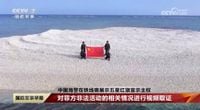In a significant escalation of tensions in the South China Sea, China has seized control of Sandy Cay, a disputed reef located just kilometers from the Philippines’ most important military outpost. The move, reported by state media, has raised concerns about a potential standoff between the two nations, which have been embroiled in territorial disputes for years.
According to a report by the China Coast Guard, the agency "implemented maritime control and exercised sovereign jurisdiction" over Sandy Cay this month, as stated by the military channel of state broadcaster CCTV. The report included images of coastguard officers unfurling the Chinese flag to declare sovereignty over the reef, which lies within the Spratly Islands.
This latest incident comes amid ongoing military exercises between the United States and the Philippines, known as the "Balikatan" exercises, which are aimed at enhancing defense cooperation between the two nations. The drills involve approximately 17,000 personnel and are designed to deter Chinese expansionism in the region.
The Philippines has not yet formally responded to China’s claim over Sandy Cay, also referred to as Tiexian Reef by Beijing. The reef is strategically located near Thitu Island, home to a significant Philippine military facility and a newly inaugurated coast guard base. The proximity of Sandy Cay to Thitu Island, which hosts around 250 residents, makes the situation particularly sensitive.
Chinese media outlets have reported that the coastguard's actions included "cleaning up plastic bottles, wooden sticks, and other debris" from the reef while also documenting what they termed illegal activities by Philippine forces. The Global Times, an English-language newspaper affiliated with the Chinese Communist Party, published photographs of the coastguard operation, which it claimed took place in mid-April.
As tensions continue to mount, the Philippine Navy has reported sightings of Chinese warships near its waters. Just days before the coastguard's actions at Sandy Cay, the Chinese aircraft carrier Shandong was detected approximately 2.23 nautical miles southwest of Babuyan Island, located in the northern part of the Philippines. Furthermore, three other Chinese vessels were spotted about 60 kilometers from Zambales, a coastal province north of Manila.
During the Balikatan exercises, which began on April 21 and will run until May 9, U.S. and Filipino forces conducted integrated defense drills. On April 27, the U.S. Marine Corps utilized its new MADIS short-range air defense system to successfully neutralize drones during a coastal defense exercise in Zambales. This collaboration aimed to enhance the collective capabilities of both nations in the face of increasing threats from China.
U.S. Defense Secretary Pete Hegseth has publicly stated that the United States is "doubling down" on its alliance with the Philippines, emphasizing the need for deterrence against perceived threats from China. Meanwhile, the Chinese foreign ministry has condemned the Balikatan exercises, labeling them a destabilizing factor in the region and accusing the Philippines of colluding with external powers.
The ongoing tensions are not new. In January 2025, vessels from the Philippine Bureau of Fisheries were harassed by Chinese coastguard ships while conducting surveys around Sandy Cay. The aggressive maneuvers of the Chinese vessels forced the Philippine ships to withdraw without completing their mission, highlighting the ongoing confrontations in the area.
China's claims in the South China Sea, including Sandy Cay, have been dismissed by an international tribunal, which ruled that Beijing's assertions have no legal basis. Despite this, China continues to assert its sovereignty over nearly the entire South China Sea, a stance that has drawn criticism from the Philippines and other neighboring countries.
As the situation develops, it remains to be seen how the Philippines will respond to China's latest actions. The Philippine government has previously accused China of escalating maritime aggression, while Beijing continues to reject these allegations, insisting on its claims to the region.
The strategic importance of Sandy Cay cannot be overstated. Its location, less than three kilometers from Thitu Island, reinforces the Philippines' military presence in the Spratly Islands, which is crucial for maintaining its sovereignty and territorial integrity. This incident underscores the volatile nature of the South China Sea disputes, where military posturing and diplomatic tensions are ever-present.
As military exercises continue and both nations navigate this complex geopolitical landscape, the potential for conflict remains a pressing concern. With the eyes of the world watching, the actions taken in the coming days will be critical in shaping the future of the South China Sea.





